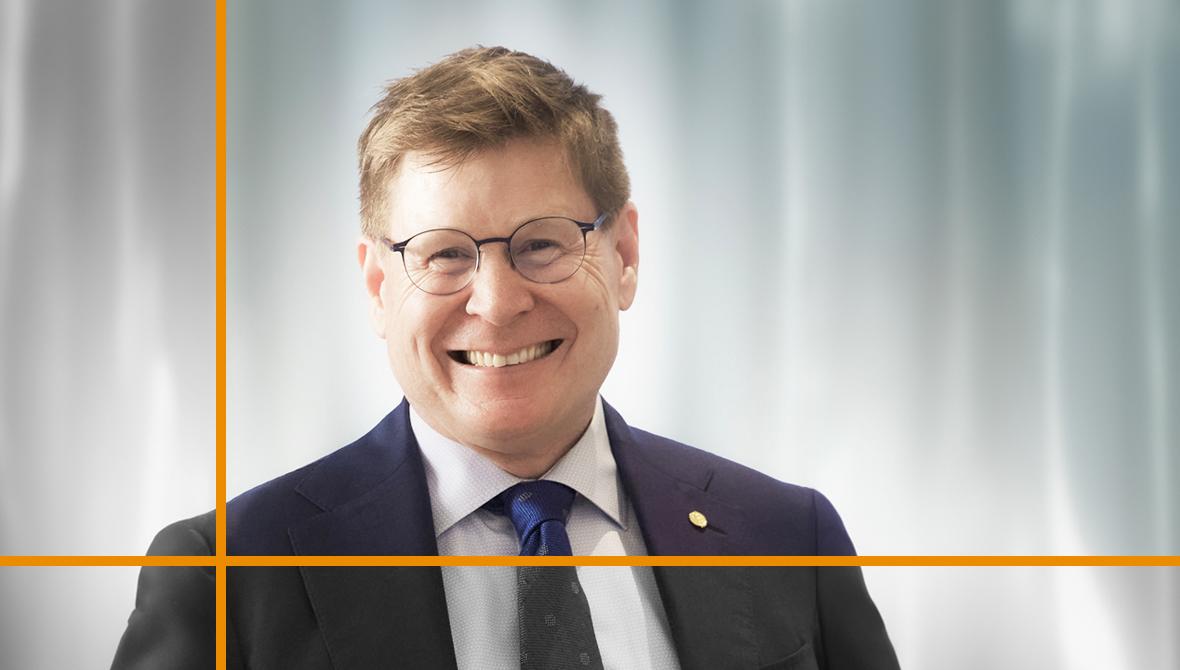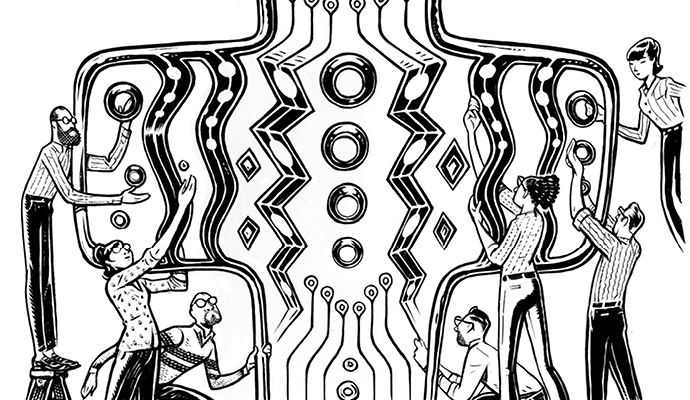Sun Life is building a culture of growth and transformation
CEO Kevin Strain is nurturing a company culture that balances short-term agility with long-term outcomes.

This interview is part of the Inside the Mind of the CxO series, which explores a wide range of critical decisions faced by chief executives around the world.
When Kevin Strain was appointed chief executive officer of the Toronto-based insurer Sun Life in 2021, he built his strategy around a core principle of the centuries-old insurance industry: thinking long-term and building sustainable businesses. That was at the height of the pandemic, when many CEOs were preoccupied with short-term financial pressures. And that preoccupation continues today, according to PwC’s 26th Annual Global CEO Survey. Fully half (51%) of insurance CEOs list the impacts of inflation as their top concern for the next year, followed by economic volatility (37%) and geopolitical risk (23%).
But Strain’s long-term view shows an acute awareness of another important finding: more than a third (37%) of insurance chief executives say their company will not be economically viable in ten years’ time if they continue on their current path. He has been close to the company’s transformation agenda in several senior roles—including a tenure as global chief financial officer from 2017 to 2021 and head of Asian operations from 2012 to 2017—leveraging a transformation tool kit that includes using deals to expand capabilities, working more effectively in broader ecosystems, and fostering a culture that finely balances its people and its technology.
Sun Life, which ranks 250 on the 2023 Forbes Global 2000 and operates in 28 markets, has evolved from a traditional insurer to a fully diversified financial institution offering pensions, annuities, and health and wellness benefits, including a large presence in asset management with more than US$1.3 trillion in assets under management.
Strain’s recent priorities include extending Sun Life’s distribution and market share, and divesting from capital-intensive activities. In 2022, he oversaw the company’s second-biggest acquisition to date: the purchase of US dental benefits provider DentaQuest for US$2.5 billion. He has also built partnerships with Canadian and US healthcare providers to offer additional clinical services to customers and has created inroads in Asia into bancassurance—a global B2B2C insurance market in which banks distribute an insurer’s products directly to their clients. That market is estimated to reach $1.8 trillion by 2031. As part of a significant deal to sell its legacy UK life and pension policies and annuity blocks this year to the Phoenix Group, Strain entered into a long-term arrangement to continue to manage approximately $8 billion in assets on behalf of the acquirer.
Strain recently sat down with strategy+business to discuss his strategy for growth and expansion. He shared his views on the key role culture will play in helping Sun Life become a more agile and digital company as it looks to unite the best of human and technological capabilities and stay ahead of disruptive forces of change, such as generative artificial intelligence.
S+B: How has your strategy evolved in light of the current, near-term economic disruptions, including inflation and interest rate volatility?
STRAIN: If you look at the interest rate environment over a long period of time, I would say interest rates today are more normal than where they have been in the past ten years. And in the long term for insurance companies, higher interest rates mean that we can potentially generate higher returns from our investments. So, the current rates are generally supportive of our business model.
Of course, there are certain impacts on businesses in the short term. But given the way that we set up our business—one of these things we do really well is to ensure that our assets and our liabilities are matched—we have the ability to absorb the market changes over the long term.
S+B: Your growth strategy includes new deals outside Canada, notably through recent acquisitions in the United States and Asia. How do you approach making significant moves at a time of so much uncertainty?
STRAIN: I look at it as a question of scale. If you think of Canada, where we’re headquartered, as a country of 40 million people, it’s one-tenth the size of the US. We have more clients in the United States than there are Canadians. Our expansion into the US was really important—and Asia’s going to be equally important. Getting expansion right is important to the long-term future of any company for that reason, based on the relative size of economies around the world and the opportunities they offer.
Having scale and being global are really important. When you’ve got that global perspective—we’ve been a global company for some time—what you learn is that understanding the local nature of your businesses can yield important outcomes.
S+B: How do you draw on your time in a leadership role for the company in Asia to inform this approach?
STRAIN: When I ran our Asia business between 2012 and 2017, one of the things I tried to do was to appoint local CEOs and key executives in our Asian operations. Often, they would be supported by somebody from the broader Sun Life team, to create a really good balance between local and global approaches to our business. I didn’t think as much about geopolitical risk then as I do today. But having that connection with local leaders who are really talented and who understand their own environment gives me information I can use to balance how we approach these issues.
S+B: As you noted, Asia is a big part of your growth plans. How are you using deals to pursue the right capabilities and expand more broadly into new markets and ecosystems?
STRAIN: We’re now one of the largest bancassurance players in Malaysia and the Philippines, and, over the past three years, we’ve leveraged those capabilities to enter into the markets of Vietnam, Indonesia, and Hong Kong. In each case, they were capabilities that either we didn’t have in the region or didn’t have enough scale. I have a lot of confidence in delivering in these new markets, because we were able to build on the successful bancassurance partnerships that we had already established in other places in the continent.
S+B: You signed a 15-year bancassurance partnership with Hong Kong’s Dah Sing Bank as exclusive provider of life insurance to its 570,000 retail banking customers. How did you approach this deal?
STRAIN: We first started talking to them about bancassurance in 2016. When we met the chairman and CEO, we could see that there was a strong cultural fit, but the timing wasn’t right. And so we were patient, and we built the relationship. And when we thought that we had achieved a great fit, we looked to execute with speed.
It’s a great example of where we understood the capabilities we wanted. We wanted to have bancassurance in Hong Kong. We understood the cultural fit that was necessary. And we focused on building that cultural relationship and partnership with Dah Sing over a long period of time. We brought financial discipline to the transaction. As a company, we’re willing to be patient in order to achieve the alignment of our key elements.
S+B: Another noteworthy aspect of your growth story has been a pattern of extending your reach through acquisitions and investments into some very large ecosystems where insurance plays an important role but is not the dominant player, such as healthcare. Why, for example, would an insurance company want to own dentists’ offices?
STRAIN: Healthcare is an area that we’re watching closely. DentaQuest, our recent acquisition, has just under 100 dental practices in the United States. We’re also the largest investor in a company called Dialogue here in Canada, which does virtual health and wellness programs. Part of the idea behind this extension to health ecosystems is we can see a road to building a stronger business. Better dental care and virtual care also link to our purpose, to help people live healthier lives.
These are also logical extensions to our group business in the US and Canada, and to our insurance platform in Asia, through Bowtie. Bowtie sells health insurance online, but it has built a clinic where you can get a health assessment and visit a doctor of Chinese medicine. The company also has a small pharmacy. Extending into this broader health ecosystem is a great way for us to develop and learn.
S+B: You’ve grown well beyond your insurance roots, with more than $1.3 trillion in assets under management in your asset management business. And you recently furthered your reach through the purchase of a majority stake in US-based Advisors Asset Management. Can you take us through how you’re ensuring growth and resilience on that side of the business?
STRAIN: Looking at Sun Life, we’re half asset management and half protection. I no longer see asset management as an adjacency. It is a fundamental part of who we are as a financial institution. We’ve been focusing on building a large asset base and a large set of asset capabilities. These stretch from mutual fund asset management and managing public equities and public fixed income right into longer-duration assets like real estate, commercial mortgages, infrastructure, and alternatives like high-yield credit and private fixed income.
I’ll give you an example of the synergies this creates. When we were selling our UK block of business to Phoenix Group, we saw they had a big balance sheet but did not have asset management capabilities in the area we were focusing on. So we set up a strategic partnership with them that included all of our asset managers: our real estate company, BentallGreenOak; our high-yield credit business, Crescent Capital Group; and private fixed income and infrastructure under InfraRed Capital Partners.
We think about these as being a holistic set of asset management solutions across the continuum. At different times, different aspects of these solutions will be performing better. But clients will also need—like we do in our business—different asset classes to help manage their asset and liability positions, their investment positions, or their investment thesis. It all comes back to our view of how taking a prudent approach to growth and diversification within our asset management capabilities can yield positive long-term outcomes for our business.
S+B: One of the key themes coming out of our CEO Survey was the importance of people and culture in supporting a CEO’s long-term growth plans. What are you focusing on from a cultural perspective as part of your strategy for Sun Life?
STRAIN: One key aspect is trying to get people to think and act more like a digital company. This means more bias to action, more focus on outcomes. It also means bringing more IT knowledge into the business and having our IT people think more like businesspeople. For example, three years ago, when we started a digital enterprise project, the first and easiest element was modernizing our tech stack. But the second and more challenging aspect was to begin working in a more agile manner with our people. We set up a concept of an agile way of working called “two in a box,” where there’s a business leader and an IT leader working on smaller deliverables. This process has helped us deliver more quickly and be much closer to the client.
Another key aspect of culture is looking at how we make decisions, especially in a hybrid working environment. We ask: how can we make decisions more effectively by identifying who’s the decision-maker and who are the advisors? I want to get to a place where we know who the decision-maker is and where when we make a decision, we all agree to it, even if we don’t have 100% support from all those who have had a chance to give their input. As the world now changes so quickly, having that clarity of who the decision-maker is going to be is really important to us.
S+B: What impacts do new technologies such as generative AI have on your strategy to act more like a digital company?
STRAIN: Seven years ago, we were talking about whether we should move to the cloud or not. And now, 50% of our computing power is in the cloud. I believe generative AI is going to be similar. It’s going to be transformational, and it’s going to help companies do things faster and cheaper. And it creates major opportunities for us to give customers a better and quicker experience.
Seven years ago, we were talking about whether we should move to the cloud or not. And now, 50% of our computing power is in the cloud. I believe generative AI is going to be similar. It’s going to be transformational.”
But AI won’t just be about saving costs or increasing productivity. We’re going to need to combine it with a real person who’s building a relationship with the customer. The technology should allow that relationship to be formed more quickly, and with better data and better knowledge of the customer. Our people using generative AI to create better interactions is going to be really important to guide customer experience and engagement.
This also connects to creating that culture of empowerment I mentioned. You want innovation to be happening not just at the CEO level, but throughout the organization. You want people to be thinking about what they do from day to day and how technology can make it better and more efficient. We want to learn from how it is being used, and what others are doing with it. Then you want to push that understanding down into the organization, where the change can happen closer to the customer.
S+B: Establishing an agile culture includes creating an environment where people feel safe taking small-scale risks to try out new ideas. What’s your view on that aspect of an agile culture within traditional industries like insurance and asset management?
STRAIN: Part of our agile way of working is saying to people, “It’s OK to fail.” This is one of the reasons you want to have smaller decisions being made. The bigger the decision, the more people worry about failure. If we can push decisions down closer to the client, where a failure can be rectified within 24 hours, that’s a better kind of failure than in the old days, when it would take a year to execute on a new product. If we can make changes to a product, if we can add new features that are much closer to the customer, and that take two to three days to make, we can tweak it if it’s not quite right. That agile way of working is really important to creating a culture where, when you’re failing, it’s almost part of what you expected.
S+B: You have operations in 28 markets. How do you extend your culture on a global scale while fostering the strong local leadership you said is so important?
STRAIN: If you go into any of our businesses around the world, it feels like Sun Life. When we’re onboarding people, especially senior people, we look carefully at whether they fit the culture. Are they client focused? Are they collaborative? Are they team builders? Do they think about diversity, and do they think diversely? And then we bring our senior leaders together in multiple forums so they can experience the culture together. Finding those opportunities to interact is really important to driving that connection to the company.
On top of that, we try to make sure people like me and my executive team go to these countries regularly so we can learn about the people there, and they can learn about us. Building a strong global company means hiring people that we think will fit the environment, and then immersing them in our culture while creating opportunities for us all to learn from one another.
Author profiles:
- Allan Buitendag is a partner in PwC Canada’s financial-services practice.
- Glenn Kauth is a content and editorial manager with PwC Canada.



